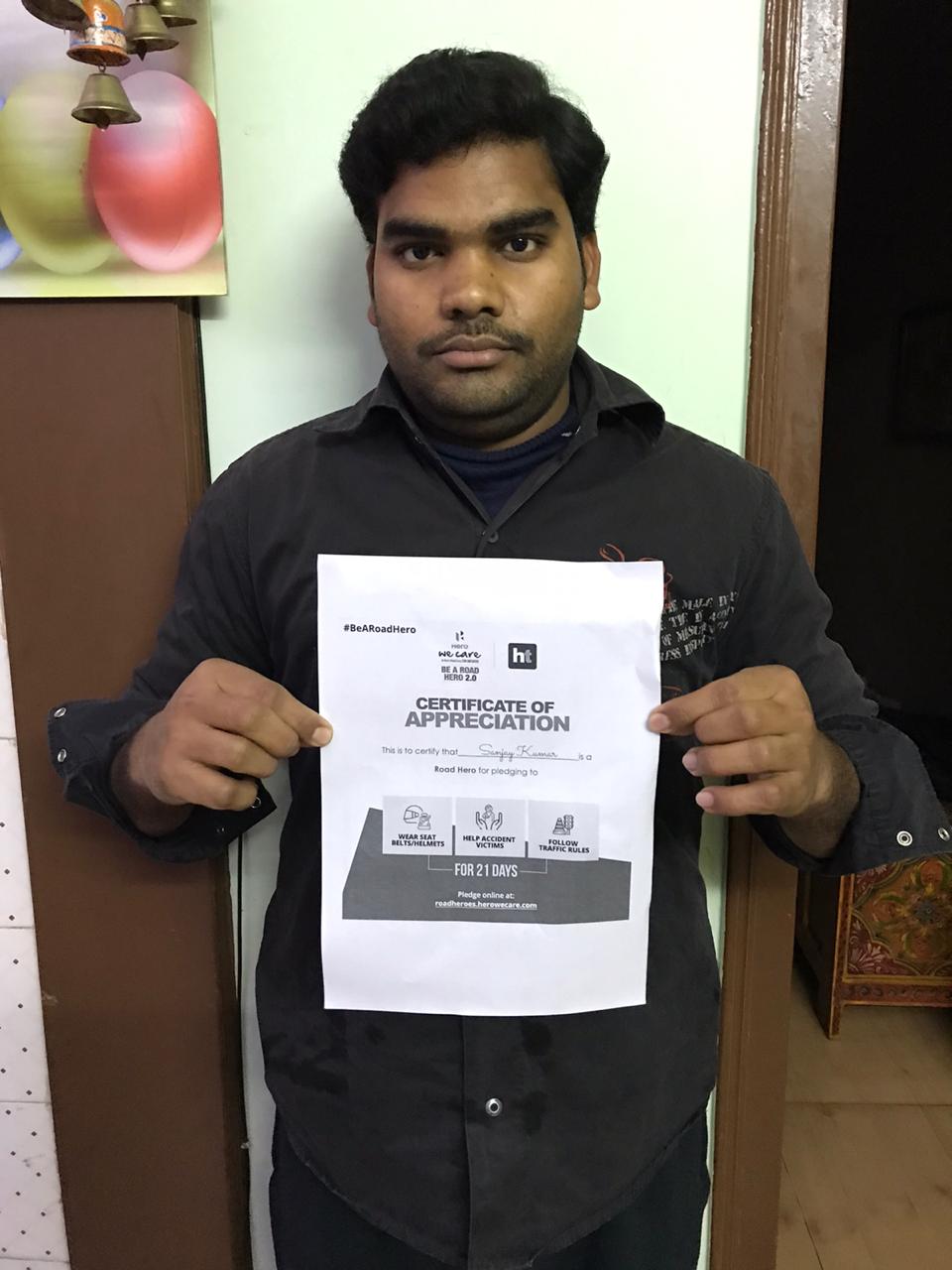Hero MotoCorp: Empowering Everyone to Be Road Heroes
Hero We Care’! Hero MotoCorp’s CSR initiative invites all riders to join their #BeARoadHero campaign, where every choice you make contributes to safer roads
Read more...
 SAJAD ALI
SAJAD ALI
 Sanjay Kumar
Sanjay Kumar
India witnesses 5 lakh accidents every year, in which nearly 1.5 lakh lives are lost and nearly 3 lakh people are injured. Highlighting the same, Union Minister of Road Transport and Highways Nitin Gadkari says: “I believe that with the cooperation of all stakeholders, we will be able to reduce the number of accidents in the country.”
The Minister also extends his support to the ‘Be A Road Hero’ campaign launched by Hindustan Times and Hero MotoCorp. You, too, can show your support by taking the road safety pledge here:
Imagine you’re going somewhere when you see a road accident victim. Would you immediately go to the person’s rescue or walk away, pretending that it never happened? If you think that most people would do the former, then you’re mistaken. A whopping 88% of Indians have expressed reluctance to help accident victims due to the fear of legal hassles, a study by SaveLIFE Foundation says. But, that’s not how it should be. This video tells you why. #BeARoadHero
The second phase of the Be A Road Hero campaign began on December 2, 2019. Launched by Hindustan Times, in association with Hero MotoCorp, it urges everyone to lead by example when it comes to matters of road safety. This includes pledging to wear seat belts/helmets, help accident victims, and follow traffic rules for 21 days.
We caught up with some of those people who had pledged last time. Watch to know why they decided to be a part of this movement.
Hero We Care’! Hero MotoCorp’s CSR initiative invites all riders to join their #BeARoadHero campaign, where every choice you make contributes to safer roads
Read more...There are reports of lakhs of road accidents annually in our country. Mr. Gadkari’s message sheds light on the initiatives that we as individuals need
Read more...These stories, as told by citizens, demonstrate why it’s important to lead by example in matters of road safety.
Read more...Kids from over 400 schools across the Delhi-NCR region let their creative juices flow to participate in Kaleidoscope, the annual inter-school painting competition organized by
Read more...The surge in road accidents has been an eye-opener for many, who now hold road safety in the highest regard. We spoke to citizens to
Read more...Road accidents claim more than 1.35 million lives in India each year. We spoke to citizens to find out what they think are the traffic
Read more...Delhi Traffic Police data shows that out of 1,690 people who died in road accidents in Delhi last year, at least 5-7% were under the
Read more...The new motor vehicles act had come with the promise of improving road safety in the national capital by bringing bad driving practices under the
Read more...Hero MotoCorp rolls out Phase 2 of Be a Road Hero campaign. India recently earned the ignominious No 1 rank for the number of road
Read more...Following basic traffic rules and not getting distracted by the thrills of speed and the joys of music can help save lives. It was a
Read more...The most common ones include not wearing a seat belt or a helmet because ‘I am just going around the corner’ or breaking a road
Read more...In the backdrop of the growing number of road accidents in India, Union Minister for Road Transport and Highways Nitin Gadkari has a message for
Read more...The road safety body has urged the government to include victims under health insurance scheme Ayushman Bharat. India accounts for more than 11 per cent
Read more...The Minister also called upon citizens to practise road safety. To join the movement, take the pledge today. Building awareness about road safety can go
Read more...The onus of keeping ourselves safe on the road lies with us. Take the pledge today. “We need to glamourise the idea of wearing helmets.
Read more...People talk about a traffic violation that they have committed in recent times, and what the incident taught them about road safety. All of us
Read more...Through a road safety initiative, Hindustan Times and Hero We Care have joined hands to help affected students get access to scholarships. Have you ever
Read more...Having lost a loved one in a highway accident, this family is working towards creating awareness about road safety. “His voice still rings in my
Read more...A family who lost their young son in a road accident are now working towards the cause of similar victims. “It is any parent’s worst
Read more...According to the Global Status Report on Road Safety 2018, India continues to record a high number of fatalities resulting from road accidents. This is
Read more...From Singapore’s safe pedestrian rule to Germany’s credit system— here’s a list of the most awe-inspiring traffic laws. With the global population swelling and access
Read more...Hero MotoCorp’s ‘Hero We Care initiative’ creates awareness about the need to wear a helmet when riding a two-wheeler, ensuring that seat belts are fastened
Read more...Hero MotoCorp’s latest initiative—Hero We Care—offers us a golden opportunity to practise road safety. Remember driving past warning signs on highways that read, ‘Speed Thrills
Read more...The number of two-wheelers on the roads of Delhi is increasing every day, and with it, the number of riders plying the streets without helmets
Read more...ROAD SAFETY AWARENESS ACTIVITIES
ROAD SAFETY AWARENESS ACTIVITIES
Be A Road Hero 3.0 campaign aims at making our roads safer for both vehicle occupants and pedestrians. Fatalities from road accidents have been steadily going up, a large percentage of which could be avoided by taking basic safety measures such as wearing seatbelts, helmets, adhering to speed limits, following lane driving as well as offering timely help to accident victims.
Under a unique CSR initiative called Hero We Care, Hero MotoCorp and Hindustan Times have joined hands to bring about a positive change in society. We encourage citizens to recognize the urgency and make a proactive shift in improving safety on our roads.
The campaign, which aims to build awareness through print, radio and digital, appoints Road Heroes who take a pledge and set an example for the community.
Join the movement. #BeARoadHero